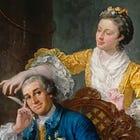
Consider, if you will, the double duty done by ‘that’ in the following piece of pedestrian prose, a bit of legalese preserved for posterity by an unsung stenographer working for the Supreme Court of the great State of Missouri a little more than a century ago.
… the witness testified on cross examination that lots 40 and 49 lying north of the Swope Addition is the McClintock property at the northeastern corner of Twelfth and Walnut; that that piece of property has been immensely enhanced in value over the last five years …The first ‘that’ in this example serves as a relative pronoun. As such, it connects two parts of a sentence. The second ‘that’ performs demonstrative work, drawing attention to the place so recently described.
Thanks to this division of labor, the conjunction of ‘thats’ makes perfect grammatical sense. Nonetheless, it offends the eyes, and, when the stenographer read back the testimony he recorded more than a century ago, I suspect that it threw a cognitive curve ball at several of the people in the courtroom.
With that in mind, I offer four tricks that writers can use to keep the dreaded double ‘that’ out of their writing.
Tip 1: Replace the demonstrative ‘that’ with ‘those’.
In the aforementioned example, two lots had been joined together to form one parcel of land. Thus, the author enjoyed the option of describing them as a plural phenomenon, thereby replacing ‘that that piece of property’ with ‘that those pieces of property’.
Tip 2: Use ‘in question’, ‘at issue’, or another phrase of that ilk.
that the piece of property under discussion has grown in valueTip 3: Find the human being in the story, whom you should describe as ‘who’.
that the person who owned the property has seen it grow in valueTip 4: Revive ‘said’.
that said piece of property has grown in valueFor Further Reading:






Hear, hear!